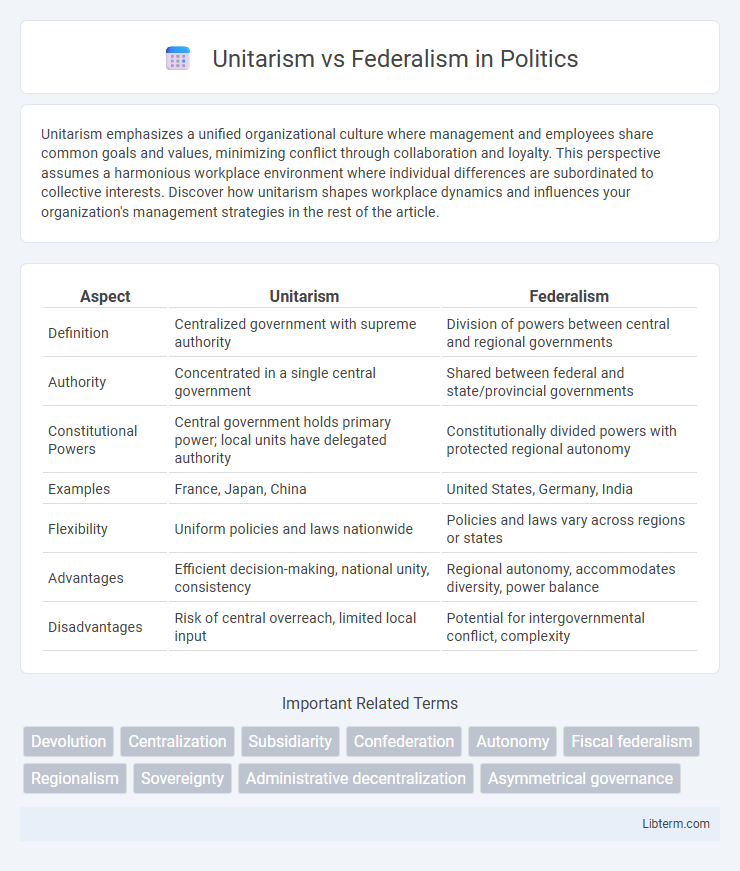Unitarism emphasizes a unified organizational culture where management and employees share common goals and values, minimizing conflict through collaboration and loyalty. This perspective assumes a harmonious workplace environment where individual differences are subordinated to collective interests. Discover how unitarism shapes workplace dynamics and influences your organization's management strategies in the rest of the article.
Table of Comparison
| Aspect | Unitarism | Federalism |
|---|---|---|
| Definition | Centralized government with supreme authority | Division of powers between central and regional governments |
| Authority | Concentrated in a single central government | Shared between federal and state/provincial governments |
| Constitutional Powers | Central government holds primary power; local units have delegated authority | Constitutionally divided powers with protected regional autonomy |
| Examples | France, Japan, China | United States, Germany, India |
| Flexibility | Uniform policies and laws nationwide | Policies and laws vary across regions or states |
| Advantages | Efficient decision-making, national unity, consistency | Regional autonomy, accommodates diversity, power balance |
| Disadvantages | Risk of central overreach, limited local input | Potential for intergovernmental conflict, complexity |
Introduction to Unitarism and Federalism
Unitarism centralizes political power within a single national government, ensuring uniform policies and laws across all regions, which simplifies administration and fosters national unity. Federalism divides sovereignty between national and subnational governments, allowing regional authorities to exercise autonomy in areas like education and law enforcement, promoting diversity and local governance. Understanding the structural differences between unitarism and federalism is crucial for analyzing how states organize power distribution and manage regional interests.
Defining Unitarism: Centralized Governance
Unitarism is defined by a centralized governance structure where a single central authority holds the majority of political power, with limited or no autonomy granted to subnational units. This system emphasizes uniformity in lawmaking and administration across the entire state, ensuring consistent policy implementation. Centralized decision-making in unitarism contrasts sharply with federalism, where power is constitutionally divided between central and regional governments.
Exploring Federalism: Power Sharing Structures
Federalism is a political system where sovereignty is constitutionally divided between a central authority and constituent political units, such as states or provinces, allowing for shared governance and autonomy. Power sharing structures in federalism enable regional governments to enact laws, collect taxes, and manage resources independently while coordinating with the federal government on national issues. This decentralized approach contrasts with unitarism by promoting local participation, accommodating diversity, and balancing authority to prevent central dominance.
Historical Origins and Evolution
Unitarism originated from the desire for centralized control, as seen in early nation-states like France post-Revolution, emphasizing a singular legal and administrative framework. Federalism evolved from the necessity to balance power between central and regional governments, exemplified by the formation of the United States Constitution in 1787, which allocated sovereignty to both states and the federal government. Over time, federalism adapted to accommodate diverse populations and regional autonomy, while unitarism often maintained strict central authority to ensure political unity and uniform policy implementation.
Key Features of Unitarist Systems
Unitarist systems centralize authority, where a single central government holds supreme power and local governments operate under its control without autonomous legislative authority. Decision-making processes are streamlined, ensuring uniform policies and laws across the entire nation, minimizing regional disparities. Administrative uniformity and centralized fiscal control are core features that enhance state cohesion and efficient governance.
Essential Characteristics of Federalist Systems
Federalist systems feature a constitutional division of powers between central and regional governments, ensuring each level operates independently within its own jurisdiction. Essential characteristics include a written constitution that outlines the allocation of authority, a dual system of government with autonomous units, and mechanisms for resolving disputes between levels of government, such as constitutional courts. These elements promote balance and protect regional interests while maintaining national unity.
Advantages and Disadvantages of Unitarism
Unitarism centralizes political power within a single national government, promoting uniform policies and streamlined decision-making, which enhances administrative efficiency and national unity. However, this concentration of power can limit regional autonomy, reduce local representation, and disregard diverse local needs, potentially resulting in alienation or inefficiency at decentralized levels. While unitarism benefits countries seeking strong centralized control and cohesion, it may struggle in large, diverse nations where federalism's regional authority better addresses varied interests.
Pros and Cons of Federalism
Federalism offers the advantage of allowing regional governments to tailor policies to local needs, promoting political diversity and preventing the concentration of power in a central authority. However, federal systems can lead to duplication of services, increased government spending, and potential conflicts between state and national laws. The division of power in federalism enhances democratic participation but can also result in inconsistent regulations and complexities in policy implementation.
Global Examples: Unitarist and Federalist Countries
Unitarist countries such as France, Japan, and China centralize political authority within a single national government, ensuring uniform policies across all regions. Federalist countries like the United States, Germany, and Australia distribute power between national and regional governments, allowing states or provinces significant autonomy. This division in governance structure impacts policy implementation, political stability, and cultural diversity management worldwide.
Comparative Analysis and Contemporary Relevance
Unitarism centralizes political power within a single government, ensuring uniform policies and administration, while federalism distributes authority across multiple levels, allowing regional autonomy and localized governance. Comparative analysis reveals that unitary states often benefit from streamlined decision-making and national cohesion, whereas federal systems accommodate diverse populations and mitigate regional conflicts by granting legislative independence. Contemporary relevance is evident as global trends show a resurgence in federal structures to address multiethnic societies, while unitary models persist in smaller, more homogeneous nations seeking efficiency.
Unitarism Infographic

 libterm.com
libterm.com